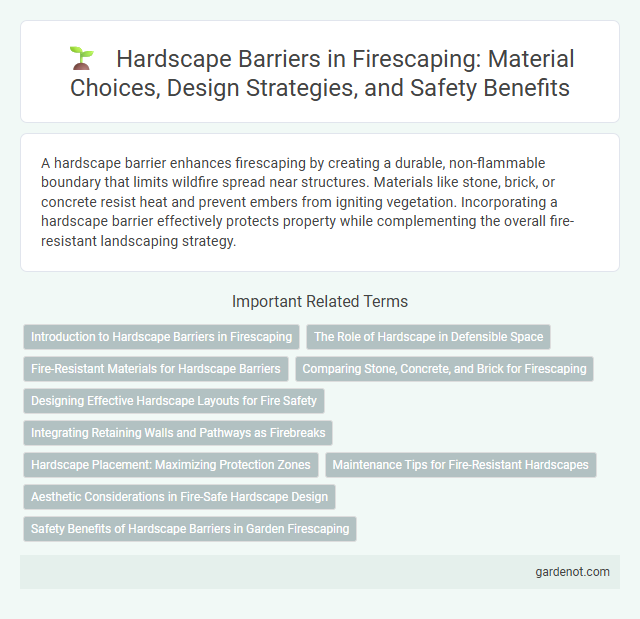A hardscape barrier enhances firescaping by creating a durable, non-flammable boundary that limits wildfire spread near structures. Materials like stone, brick, or concrete resist heat and prevent embers from igniting vegetation. Incorporating a hardscape barrier effectively protects property while complementing the overall fire-resistant landscaping strategy.
Introduction to Hardscape Barriers in Firescaping
Hardscape barriers play a crucial role in firescaping by creating effective firebreaks that prevent the spread of wildfires. Materials such as stone, concrete, brick, and metal are commonly used in these barriers due to their non-combustible properties and durability. Incorporating hardscape features like driveways, patios, or retaining walls can significantly enhance fire protection around residential and commercial properties.
The Role of Hardscape in Defensible Space
Hardscape barriers such as concrete walls, stone pathways, and gravel beds play a critical role in creating defensible space by slowing or redirecting wildfire flames and embers. These non-combustible elements reduce fuel continuity and provide safe zones for firefighters, enhancing property protection during wildfires. Proper installation and maintenance of hardscape features significantly improve landscape resilience against fire spread.
Fire-Resistant Materials for Hardscape Barriers
Hardscape barriers made from fire-resistant materials such as concrete, stone, and brick significantly reduce the risk of fire spreading in vulnerable areas. These non-combustible materials create effective physical separations between vegetation and structures, enhancing overall wildfire resilience. Incorporating fire-resistant hardscape barriers is a critical component in creating defensible space around homes and properties.
Comparing Stone, Concrete, and Brick for Firescaping
Stone offers natural heat resistance and durability, making it an ideal hardscape barrier for firescaping with minimal maintenance. Concrete provides a cost-effective and versatile option that can be molded into various shapes but may require sealing to enhance its fire resistance. Brick combines aesthetic appeal and fireproof qualities, creating a durable barrier that withstands high temperatures and complements landscape design.
Designing Effective Hardscape Layouts for Fire Safety
Designing effective hardscape layouts for fire safety involves creating non-combustible zones using materials like concrete, stone, and gravel to act as barriers that slow or stop wildfire spread. Strategic placement of retaining walls, patios, driveways, and pathways can reduce fuel continuity, improving the defensible space around structures. Incorporating wide, clear hardscape areas minimizes ember accumulation and provides safe access for firefighting personnel during emergencies.
Integrating Retaining Walls and Pathways as Firebreaks
Integrating retaining walls and pathways as firebreaks within firescaping strategies enhances property protection by creating effective physical barriers that slow wildfire spread. Retaining walls constructed from non-combustible materials like stone or concrete can interrupt fuel continuity, while pathways made of gravel or pavers reduce vegetation buildup and limit fire access routes. Strategically placing these hardscape elements within defensible spaces improves overall landscape resilience and fire mitigation efforts.
Hardscape Placement: Maximizing Protection Zones
Strategic hardscape placement creates effective fire barriers by using non-combustible materials such as stone, concrete, and brick to interrupt fuel continuity and slow fire spread. Positioning patios, driveways, and retaining walls within defensible space maximizes protection zones around structures by reducing vegetation density and heat exposure. Properly designed hardscape barriers enhance overall landscape resilience by providing clear separation between flammable plants and buildings.
Maintenance Tips for Fire-Resistant Hardscapes
Fire-resistant hardscapes, such as stone, concrete, and brick, require regular maintenance to ensure their effectiveness as a protective barrier against wildfires. Remove debris, dry leaves, and flammable vegetation from cracks and edges to prevent fire ignition points. Inspect and repair any damage promptly, sealing gaps and cracks to maintain continuous fire resistance and prevent heat transfer.
Aesthetic Considerations in Fire-Safe Hardscape Design
Hardscape barriers in firescaping combine functionality with visual appeal, integrating materials like stone, brick, or concrete that resist flames while enhancing landscape style. Strategic placement of these elements creates effective firebreaks without compromising garden design, ensuring safety aligns with aesthetic harmony. Incorporating textured finishes and complementary colors further elevates the fire-safe hardscape, blending seamlessly with natural surroundings.
Safety Benefits of Hardscape Barriers in Garden Firescaping
Hardscape barriers such as stone walls, gravel paths, and concrete edging create effective firebreaks that slow or stop the spread of flames in garden firescaping. These barriers reduce the availability of flammable materials near structures, significantly lowering the risk of fire damage and enhancing overall property safety. Incorporating hardscape elements strategically around vegetation and buildings improves fire resistance and provides critical protection during wildfire events.
Hardscape barrier Infographic

 gardenot.com
gardenot.com